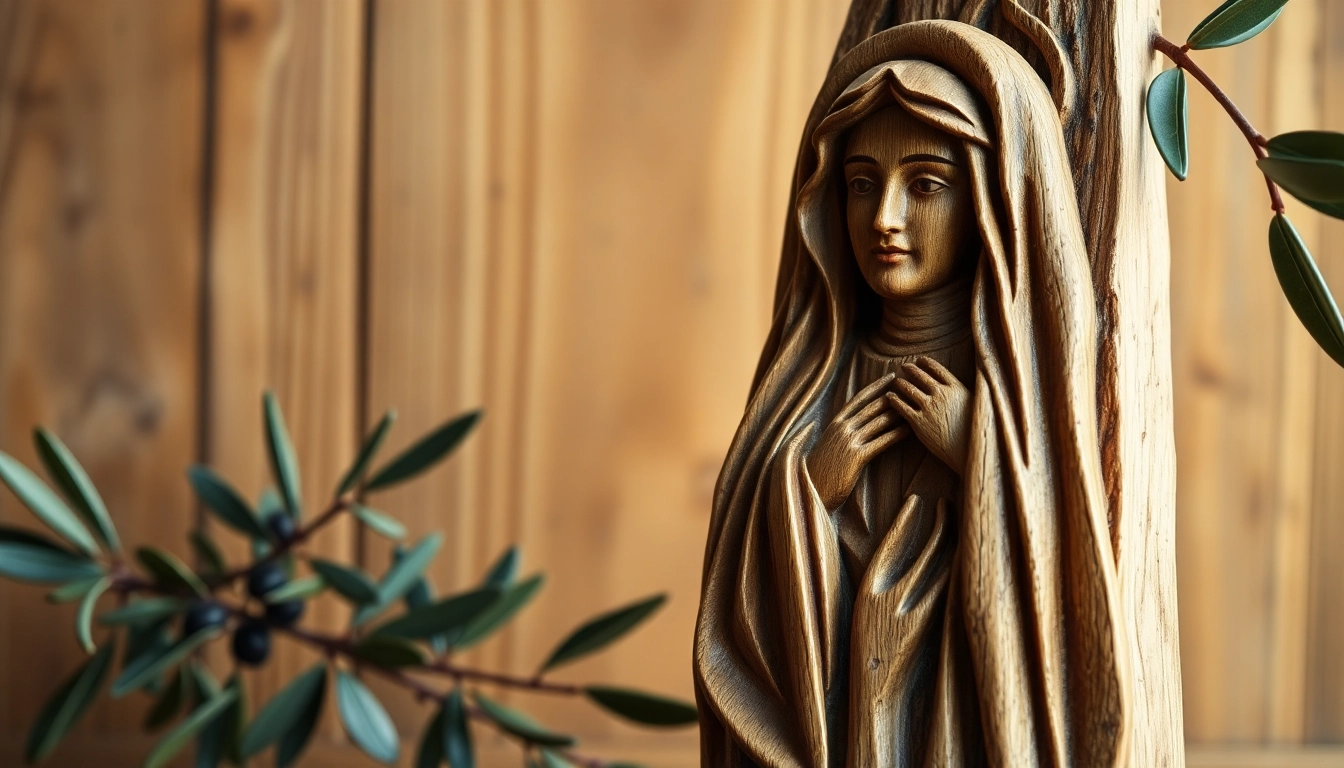Olive wood carvings represent a rich tradition deeply embedded in the landscapes and cultures of the Mediterranean region, particularly within the Holy Land. The intricate craftsmanship and artistry behind these carvings make them not just decorative items but also meaningful representations of faith, history, and heritage. As you explore the beauty and significance of olive wood carvings, you will discover their compelling history, the artisan techniques involved, and their varied uses in modern settings.
Understanding Olive Wood Carvings
History and Significance of Olive Wood Carvings
Olive wood carving has a long-standing heritage that dates back hundreds of years. The olive tree, revered for its resilience and longevity, serves as a symbol of peace and hope. In religious contexts, it holds a special place, making the wood a favored medium for creating sacred art, especially in Christianity. From the olive groves of Bethlehem and Jerusalem, artisans have carved these works of art, reflecting both religious devotion and local culture. Such carvings are often seen as heirlooms passed through generations, each piece telling stories of faith and artistic legacy.
Characteristics of Quality Olive Wood Carvings
Quality olive wood carvings are distinguished by their unique color variations, intricate patterns, and fine grain. The wood typically exhibits a beautiful, warm hue ranging from light to dark shades of brown, with its characteristic grain providing distinctive textures. Artisans often select wood from mature olive trees, specifically prunings that maintain the tree’s health while also providing raw materials for crafting stunning carvings. A hallmark of authentic pieces is the attention to detail in carving, reflecting the skill and dedication of the artisan.
Techniques Used in Olive Wood Carving
The art of olive wood carving involves several traditional techniques that have been passed down through generations. These include:
- Chiseling: Artisans use chisels to carefully carve out intricate designs, ensuring that each piece captures the beauty of the wood.
- Whittling: This technique involves slowly removing small pieces of wood with a knife to create fine details.
- Finishing: Finally, the carvings are often treated with natural oils to enhance their durability and give them a smooth, polished finish.
Types of Olive Wood Carvings
Religious Olive Wood Carvings
Religious olive wood carvings comprise a significant portion of this art form. They often depict scenes from the Bible, crucifixes, and figures of saints, making them popular items for both personal devotion and gifts. Many of these pieces serve as symbols of faith and are frequently used in churches and homes to inspire spirituality. Well-crafted religious carvings resonate with visitors, engaging them in contemplative reflection and reverence.
Decorative Olive Wood Carvings
Beyond their religious significance, olive wood carvings also serve purely decorative purposes. These artworks can take the form of intricate figurines, statuary, and ornamental decorations for the home. Their natural designs, coupled with the warmth of the wood, allow them to blend seamlessly into various decor styles. Whether they are displayed on a shelf or as a centerpiece, they serve not only as conversation starters but also as timeless art pieces appreciated for their aesthetic value.
Custom Olive Wood Carvings
The rise of personalization in today’s market has opened avenues for custom olive wood carvings. Many artisans offer bespoke services, allowing clients to request specific designs, sizes, or modifications. This has made olive wood carvings a popular choice for personalized gifts and commemorative items. From engraved initials to tailored designs that celebrate specific life events, custom carvings allow individuals to own a unique piece of art that reflects their personal stories.
The Artisans Behind Olive Wood Carvings
Craftsmanship and Skills of Artisans
The artisans who create olive wood carvings possess a wealth of skill, honed through years of practice and often passed down within families. Their knowledge encompasses not only the technical aspects of carving but also a deep understanding of the wood itself—its properties and how best to work with it. The artistry involved demands patience, precision, and a creative flair, culminating in pieces that are both functional and deeply meaningful.
The Role of Tradition in Olive Wood Carving
Tradition plays a crucial role in the art of olive wood carving. Many artisans adhere to techniques and design motifs that have been utilized for centuries, preserving the cultural heritage of their craft. This blend of tradition with personal expression allows each artisan’s style to shine through, contributing to the diversity of the pieces on the market. By maintaining traditional techniques, artisans also honor their ancestors and keep their legacy alive through their work.
Supporting Local Communities through Packaging
Purchasing olive wood carvings not only supports individual artisans but also contributes to the wider community. Many artisans work in cooperative settings, which promote fair wages and sustainable practices. These cooperatives ensure that the profits from sales are reinvested into local communities, providing education and helping preserve the olive wood carving tradition. By choosing to buy olive wood carvings, you become a part of a movement that supports artisans and their communities, fostering economic development and cultural preservation.
Sourcing and Purchasing Olive Wood Carvings
Where to Find Authentic Olive Wood Carvings
Authentic olive wood carvings can be found in various places, but sourcing them from reputable vendors is vital. Look for local artisan markets, specialty shops, and galleries that showcase the work of local artisans. Additionally, several online platforms offer a selection of authentic olive wood carvings directly from artisans. It’s important to verify the authenticity of the seller to ensure you are getting genuine pieces.
Online vs. Local Shopping for Olive Wood Carvings
Both online and local shopping for olive wood carvings come with their advantages and challenges. Shopping locally allows for a tactile experience—seeing the carvings in person provides an opportunity to appreciate their details and craftsmanship fully. However, online shopping expands access to a broader range of artisans and unique pieces from different regions. It’s essential to balance convenience and the desire for authenticity when choosing where to purchase.
What to Consider When Buying Olive Wood Carvings
When purchasing olive wood carvings, several factors should be considered to ensure satisfaction with your investment:
- Quality: Examine the craftsmanship—look for smooth finishes, intricate details, and overall craftsmanship that reflects the artisan’s skill.
- Origin: Understanding the source of the carving helps confirm its authenticity. Authentic pieces should originate from regions known for olive wood carving, like Bethlehem and Jerusalem.
- Purpose: Determine whether the piece is intended for decorative use, religious devotion, or as a gift, as this may influence your selection criteria.
Caring for Olive Wood Carvings
Cleaning and Maintenance Tips for Olive Wood Carvings
Maintaining olive wood carvings requires careful cleaning to preserve their natural beauty. Use a soft, dry cloth to remove dust and avoid utilizing harsh chemicals, which may damage the wood. Occasionally, applying a small amount of food-grade mineral oil can rejuvenate the wood’s luster while providing a protective layer against moisture and heat.
Preserving Your Olive Wood Carvings
To ensure the longevity of olive wood carvings, it is crucial to keep them away from direct sunlight and excessive moisture. Using coasters under mugs or vases placed on carved surfaces can help protect the carvings from unwanted stains and scratches. If a carving starts to lose its sheen, gently clean it and reapply oil to restore its glow.
Common Issues and Solutions for Olive Wood Carvings
Like all wooden items, olive wood carvings may face common issues such as cracking, fading, or surface wear. Addressing these concerns appropriately can extend their lifespan:
- For small cracks, apply food-grade wood glue and clamp the area until it sets.
- Fading can be combated by regularly dusting and keeping the pieces out of direct sunlight.
- To address surface wear, lightly sand the area and reapply mineral oil for revitalization.
In conclusion, olive wood carvings are more than mere decorative objects; they encapsulate rich cultural narratives, artistic tradition, and skilled craftsmanship. By supporting artisans through your purchases, you not only gain beautiful pieces of art but also contribute to the preservation of a cherished craft. Embracing the beauty of Olive wood carvings ensures that this time-honored tradition endures for generations to come.



